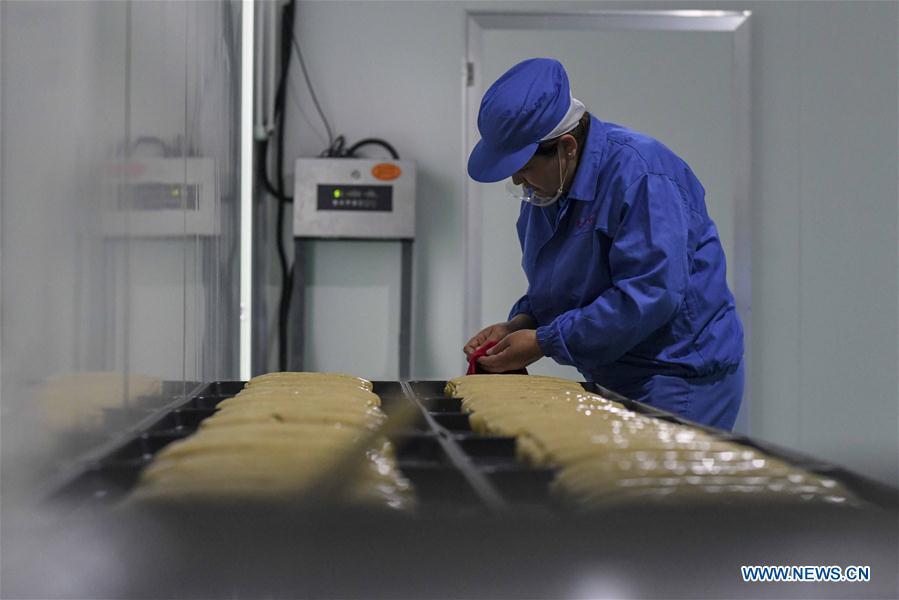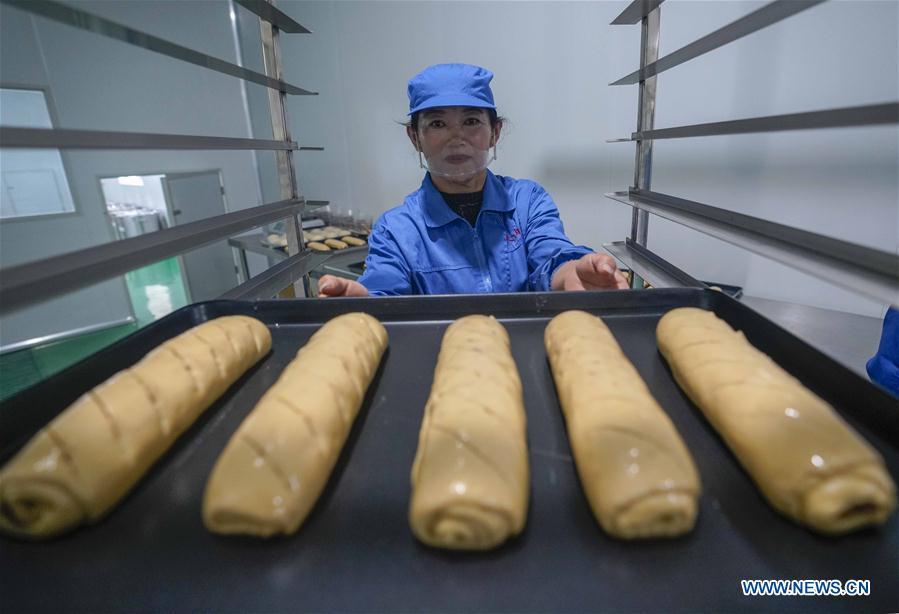Chickpea planting helps people in Xinjiang increase incomes, shake off poverty
Xinhua
1592782324000

A staff member makes chickpea breads at the workshop of an agricultural science and technology company in Toli County, northwest China's Xinjiang Uygur Autonomous Region, June 19, 2020. Located in the mountainous area with an average elevation of over 1,500 meters, Toli County is suitable for the planting of chickpeas due to its geographical conditions. In 2020, the planting of chickpea has covered an area of 13,000 mu (about 866.7 hectares) in Toli to meet the demand of the market. A total of 433 local households, including 200 poverty-stricken households, are involved into the chickpea planting, a way to help them increase incomes and shake off poverty. (Xinhua/Zhao Ge)

A staff member makes chickpea breads at the workshop of an agricultural science and technology company in Toli County, northwest China's Xinjiang Uygur Autonomous Region, June 19, 2020. Located in the mountainous area with an average elevation of over 1,500 meters, Toli County is suitable for the planting of chickpeas due to its geographical conditions. In 2020, the planting of chickpea has covered an area of 13,000 mu (about 866.7 hectares) in Toli to meet the demand of the market. A total of 433 local households, including 200 poverty-stricken households, are involved into the chickpea planting, a way to help them increase incomes and shake off poverty. (Xinhua/Zhao Ge)

A woman from a poverty-stricken household is busy on the production line at the workshop of an agricultural science and technology company in Toli County, northwest China's Xinjiang Uygur Autonomous Region, June 19, 2020. Located in the mountainous area with an average elevation of over 1,500 meters, Toli County is suitable for the planting of chickpeas due to its geographical conditions. In 2020, the planting of chickpea has covered an area of 13,000 mu (about 866.7 hectares) in Toli to meet the demand of the market. A total of 433 local households, including 200 poverty-stricken households, are involved into the chickpea planting, a way to help them increase incomes and shake off poverty. (Xinhua/Zhao Ge)

A woman from a poverty-stricken household is busy on the production line at the workshop of an agricultural science and technology company in Toli County, northwest China's Xinjiang Uygur Autonomous Region, June 19, 2020. Located in the mountainous area with an average elevation of over 1,500 meters, Toli County is suitable for the planting of chickpeas due to its geographical conditions. In 2020, the planting of chickpea has covered an area of 13,000 mu (about 866.7 hectares) in Toli to meet the demand of the market. A total of 433 local households, including 200 poverty-stricken households, are involved into the chickpea planting, a way to help them increase incomes and shake off poverty. (Xinhua/Zhao Ge)

A staff member peels the chickpeas at the workshop of an agricultural science and technology company in Toli County, northwest China's Xinjiang Uygur Autonomous Region, June 19, 2020. Located in the mountainous area with an average elevation of over 1,500 meters, Toli County is suitable for the planting of chickpeas due to its geographical conditions. In 2020, the planting of chickpea has covered an area of 13,000 mu (about 866.7 hectares) in Toli to meet the demand of the market. A total of 433 local households, including 200 poverty-stricken households, are involved into the chickpea planting, a way to help them increase incomes and shake off poverty. (Xinhua/Zhao Ge)

A staff member puts chickpea breads into the oven at the workshop of an agricultural science and technology company in Toli County, northwest China's Xinjiang Uygur Autonomous Region, June 19, 2020. Located in the mountainous area with an average elevation of over 1,500 meters, Toli County is suitable for the planting of chickpeas due to its geographical conditions. In 2020, the planting of chickpea has covered an area of 13,000 mu (about 866.7 hectares) in Toli to meet the demand of the market. A total of 433 local households, including 200 poverty-stricken households, are involved into the chickpea planting, a way to help them increase incomes and shake off poverty. (Xinhua/Zhao Ge)

A staff member packages chickpea powder at an agricultural science and technology company in Toli County, northwest China's Xinjiang Uygur Autonomous Region, June 19, 2020. Located in the mountainous area with an average elevation of over 1,500 meters, Toli County is suitable for the planting of chickpeas due to its geographical conditions. In 2020, the planting of chickpea has covered an area of 13,000 mu (about 866.7 hectares) in Toli to meet the demand of the market. A total of 433 local households, including 200 poverty-stricken households, are involved into the chickpea planting, a way to help them increase incomes and shake off poverty. (Xinhua/Zhao Ge)

A woman from a poverty-stricken household puts the packaged chickpeas into a box at an agricultural science and technology company in Toli County, northwest China's Xinjiang Uygur Autonomous Region, June 19, 2020. Located in the mountainous area with an average elevation of over 1,500 meters, Toli County is suitable for the planting of chickpeas due to its geographical conditions. In 2020, the planting of chickpea has covered an area of 13,000 mu (about 866.7 hectares) in Toli to meet the demand of the market. A total of 433 local households, including 200 poverty-stricken households, are involved into the chickpea planting, a way to help them increase incomes and shake off poverty. (Xinhua/Zhao Ge)


